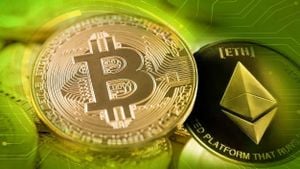On November 5th, former President Donald Trump emerged victorious in the 2024 election, marking the beginning of what many are calling Trump 2.0. This victory has ignited significant speculation and analysis surrounding its impact on the American economy and the global market environment.
Trump's return to power has stirred both excitement and trepidation, particularly due to the prevailing economic conditions. Exit polls indicated widespread dissatisfaction among voters, with nearly 45% feeling worse off financially than during Trump's previous tenure. This sentiment likely fueled his campaign messages, which promised cuts to taxes and the cultivation of more business-friendly policies, alongside pledges to address what many have termed the "inflation nightmare". Such rhetoric has created expectations of swift economic changes, propelling optimism among investors.
After his November 5th victory was confirmed, the stock market reacted explosively. On November 6th, the Dow Jones Industrial Average soared over 1,500 points—a remarkable 3.6% rise. This marks the first time the blue-chip index gained more than 1,000 points in just one day since 2022. Meanwhile, the S&P 500 rose by 146 points, approximately 2.51%, and the Nasdaq Composite posted nearly 3% gains. The Russell 2000 index, which tracks smaller companies, saw the greatest spike, climbing by almost 6%. Financial stocks appeared particularly buoyant, with the S&P 500 bank index jumping nearly 11% and Robinhood Markets reporting record-high trading volumes, 11 times above average.
Many attribute this surge to the resolution of electoral uncertainty. John Bai, a finance professor at Northeastern University, remarked, "The number one rule in the stock market is the market dislikes uncertainty. It thrives on the resolution of uncertainty." With Trump’s decisive victory, investors felt more confident making future spending and investment decisions, particularly with his expected implementation of tax-friendly policies.
The cryptocurrency market reacted similarly positive to Trump’s win, bolstered by his plans to promote the U.S. as the "crypto capital of the planet." Within just 24 hours post-election, Bitcoin skyrocketed from $69,492 to set the highest of $75,395, creating ripples of enthusiasm among investors. Trump’s previously expressed support for cryptocurrencies positions him as a “pro-crypto” candidate, making potential policy shifts all the more promising for this sector. Enthusiasts are particularly eager for Trump to dismantle current regulatory pressures, especially targeting U.S. Securities and Exchange Commission Chairman Gary Gensler, whose approach to regulating the crypto market has been viewed as excessively stringent.
But not all currency saw positive effects. Following Trump’s victory, the U.S. dollar jumped significantly, marking its largest one-day gain against other currencies since 2016. Conversely, the Mexican peso plummeted to its lowest levels in over two years, and the Euro also dipped significantly, coinciding with expectations of heightened U.S. tariffs under Trump’s regime. A strong dollar boosts confidence among U.S. investors but raises concerns about the competitiveness of U.S. exports and the ability of other nations to manage their dollar-denominated debt.
Underneath the optimistic surface of the election results lies concern over the longer-term repercussions of Trump’s anticipated economic policies. During his first term, Trump signed the 2017 Tax Cuts and Jobs Act, which was the most substantial alteration of the tax code seen over the past thirty years. If Trump goes through with his promise to extend these tax cuts, set to expire at the end of 2025, he could dramatically reduce both personal and corporate tax rates. This could potentially lead to substantial federal deficit increases—a prediction estimates up to $7.75 trillion over the next decade. The increase of government debt is already beginning to make bond investors uneasy, as indicated by rising bond yields.
Tariffs are another tool Trump plans to utilize to increase federal revenues. Proposals range from imposing a 10% tariff on all foreign goods to increasing the tariff on Chinese imports to 60%. Although intended to protect U.S. businesses, such policies could inadvertently inflate consumer prices and provoke retaliatory tariffs from other nations, especially complicators such as China and Europe. Manufacturers may rejoice at tariff protections, yet economists warn of the unintended inflationary pressure these tariffs may exert on consumers.
The immediate reaction to Trump’s election victory raises questions about how his proposed policies will shape the broader economic outlook over the coming years. Not only are investor sentiments soaring, but many analysts predict potential shifts across global markets and significant returns to U.S. worker sectors. Key industries, including construction and manufacturing, might reap the rewards of increased governmental spending due to Trump’s fiscal proposals and lower taxes. A recent report notes increased confidence in U.S. fiscal health, which may support greater construction investment, albeit hampered by anticipated labor shortages stemming from immigration cuts.
Globally, the ripples of Trump’s re-election are also being felt. Economic research group ZEW recently adjusted Germany's economic outlook downward following Trump’s new term and the collapse of its governmental coalition. Sentiments surrounding the economic prospects for Germany took significant hits, signaling concerns about Trump’s potential impact on transatlantic economic relations.
While the U.S. may see boosts in consumer confidence and business investments, the global markets could face sustained anxiety and volatility due to the potential rise of protectionist policies. Economists stress the need for careful navigation as international trade relations may become precariously unbalanced under the influence of Trump’s strategies.
Overall, the effects of Trump's election win are multi-faceted, generating immediate enthusiasm on stock exchanges and raising hopes for certain sectors, but also inciting caution among investors concerning the long-term ramifications of his proposed economic reforms. With so much at stake, both supporters and critics of Trump await the next chapter with bated breath. Will the immediate euphoria last? Or will economic pragmatism cloud the horizon? Only time will tell as the policies begin to take shape within this new economic environment.



